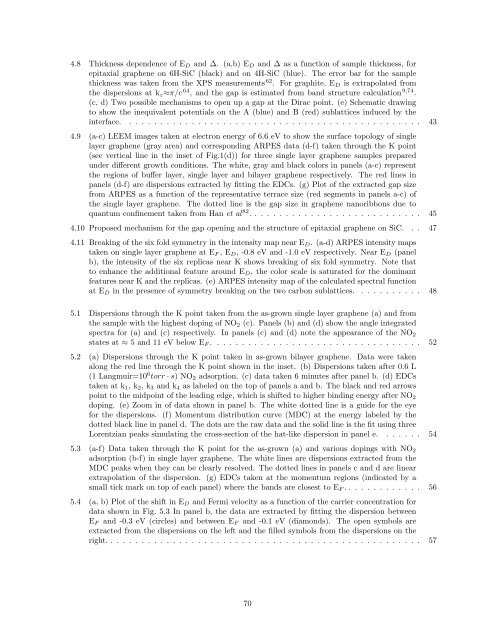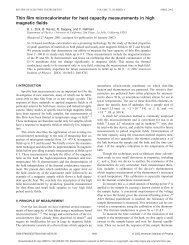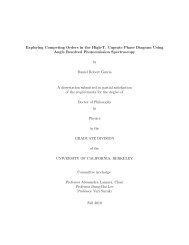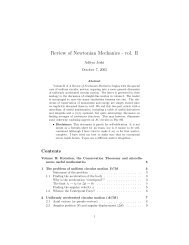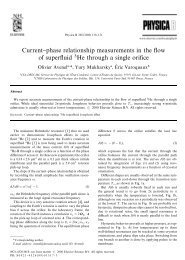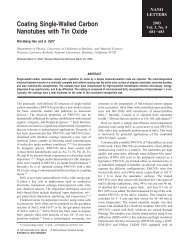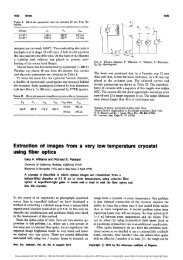Dirac Fermions in Graphene and Graphiteâa view from angle ...
Dirac Fermions in Graphene and Graphiteâa view from angle ...
Dirac Fermions in Graphene and Graphiteâa view from angle ...
You also want an ePaper? Increase the reach of your titles
YUMPU automatically turns print PDFs into web optimized ePapers that Google loves.
4.8 Thickness dependence of E D <strong>and</strong> ∆. (a,b) E D <strong>and</strong> ∆ as a function of sample thickness, for<br />
epitaxial graphene on 6H-SiC (black) <strong>and</strong> on 4H-SiC (blue). The error bar for the sample<br />
thickness was taken <strong>from</strong> the XPS measurements 62 . For graphite, E D is extrapolated <strong>from</strong><br />
the dispersions at k z ≈π/c 64 , <strong>and</strong> the gap is estimated <strong>from</strong> b<strong>and</strong> structure calculation 9,74 .<br />
(c, d) Two possible mechanisms to open up a gap at the <strong>Dirac</strong> po<strong>in</strong>t. (e) Schematic draw<strong>in</strong>g<br />
to show the <strong>in</strong>equivalent potentials on the A (blue) <strong>and</strong> B (red) sublattices <strong>in</strong>duced by the<br />
<strong>in</strong>terface. . . . . . . . . . . . . . . . . . . . . . . . . . . . . . . . . . . . . . . . . . . . . . . . 43<br />
4.9 (a-c) LEEM images taken at electron energy of 6.6 eV to show the surface topology of s<strong>in</strong>gle<br />
layer graphene (gray area) <strong>and</strong> correspond<strong>in</strong>g ARPES data (d-f) taken through the K po<strong>in</strong>t<br />
(see vertical l<strong>in</strong>e <strong>in</strong> the <strong>in</strong>set of Fig.1(d)) for three s<strong>in</strong>gle layer graphene samples prepared<br />
under different growth conditions. The white, gray <strong>and</strong> black colors <strong>in</strong> panels (a-c) represent<br />
the regions of buffer layer, s<strong>in</strong>gle layer <strong>and</strong> bilayer graphene respectively. The red l<strong>in</strong>es <strong>in</strong><br />
panels (d-f) are dispersions extracted by fitt<strong>in</strong>g the EDCs. (g) Plot of the extracted gap size<br />
<strong>from</strong> ARPES as a function of the representative terrace size (red segments <strong>in</strong> panels a-c) of<br />
the s<strong>in</strong>gle layer graphene. The dotted l<strong>in</strong>e is the gap size <strong>in</strong> graphene nanoribbons due to<br />
quantum conf<strong>in</strong>ement taken <strong>from</strong> Han et al 82 . . . . . . . . . . . . . . . . . . . . . . . . . . . . 45<br />
4.10 Proposed mechanism for the gap open<strong>in</strong>g <strong>and</strong> the structure of epitaxial graphene on SiC. . . 47<br />
4.11 Break<strong>in</strong>g of the six fold symmetry <strong>in</strong> the <strong>in</strong>tensity map near E D . (a-d) ARPES <strong>in</strong>tensity maps<br />
taken on s<strong>in</strong>gle layer graphene at E F , E D , -0.8 eV <strong>and</strong> -1.0 eV respectively. Near E D (panel<br />
b), the <strong>in</strong>tensity of the six replicas near K shows break<strong>in</strong>g of six fold symmetry. Note that<br />
to enhance the additional feature around E D , the color scale is saturated for the dom<strong>in</strong>ant<br />
features near K <strong>and</strong> the replicas. (e) ARPES <strong>in</strong>tensity map of the calculated spectral function<br />
at E D <strong>in</strong> the presence of symmetry break<strong>in</strong>g on the two carbon sublattices. . . . . . . . . . . 48<br />
5.1 Dispersions through the K po<strong>in</strong>t taken <strong>from</strong> the as-grown s<strong>in</strong>gle layer graphene (a) <strong>and</strong> <strong>from</strong><br />
the sample with the highest dop<strong>in</strong>g of NO 2 (c). Panels (b) <strong>and</strong> (d) show the <strong>angle</strong> <strong>in</strong>tegrated<br />
spectra for (a) <strong>and</strong> (c) respectively. In panels (c) <strong>and</strong> (d) note the appearance of the NO 2<br />
states at ≈ 5 <strong>and</strong> 11 eV below E F . . . . . . . . . . . . . . . . . . . . . . . . . . . . . . . . . . 52<br />
5.2 (a) Dispersions through the K po<strong>in</strong>t taken <strong>in</strong> as-grown bilayer graphene. Data were taken<br />
along the red l<strong>in</strong>e through the K po<strong>in</strong>t shown <strong>in</strong> the <strong>in</strong>set. (b) Dispersions taken after 0.6 L<br />
(1 Langmuir=10 6 torr · s) NO 2 adsorption. (c) data taken 6 m<strong>in</strong>utes after panel b. (d) EDCs<br />
taken at k 1 , k 2 , k 3 <strong>and</strong> k 4 as labeled on the top of panels a <strong>and</strong> b. The black <strong>and</strong> red arrows<br />
po<strong>in</strong>t to the midpo<strong>in</strong>t of the lead<strong>in</strong>g edge, which is shifted to higher b<strong>in</strong>d<strong>in</strong>g energy after NO 2<br />
dop<strong>in</strong>g. (e) Zoom <strong>in</strong> of data shown <strong>in</strong> panel b. The white dotted l<strong>in</strong>e is a guide for the eye<br />
for the dispersions. (f) Momentum distribution curve (MDC) at the energy labeled by the<br />
dotted black l<strong>in</strong>e <strong>in</strong> panel d. The dots are the raw data <strong>and</strong> the solid l<strong>in</strong>e is the fit us<strong>in</strong>g three<br />
Lorentzian peaks simulat<strong>in</strong>g the cross-section of the hat-like dispersion <strong>in</strong> panel e. . . . . . . 54<br />
5.3 (a-f) Data taken through the K po<strong>in</strong>t for the as-grown (a) <strong>and</strong> various dop<strong>in</strong>gs with NO 2<br />
adsorption (b-f) <strong>in</strong> s<strong>in</strong>gle layer graphene. The white l<strong>in</strong>es are dispersions extracted <strong>from</strong> the<br />
MDC peaks when they can be clearly resolved. The dotted l<strong>in</strong>es <strong>in</strong> panels c <strong>and</strong> d are l<strong>in</strong>ear<br />
extrapolation of the dispersion. (g) EDCs taken at the momentum regions (<strong>in</strong>dicated by a<br />
small tick mark on top of each panel) where the b<strong>and</strong>s are closest to E F . . . . . . . . . . . . . 56<br />
5.4 (a, b) Plot of the shift <strong>in</strong> E D <strong>and</strong> Fermi velocity as a function of the carrier concentration for<br />
data shown <strong>in</strong> Fig. 5.3 In panel b, the data are extracted by fitt<strong>in</strong>g the dispersion between<br />
E F <strong>and</strong> -0.3 eV (circles) <strong>and</strong> between E F <strong>and</strong> -0.1 eV (diamonds). The open symbols are<br />
extracted <strong>from</strong> the dispersions on the left <strong>and</strong> the filled symbols <strong>from</strong> the dispersions on the<br />
right. . . . . . . . . . . . . . . . . . . . . . . . . . . . . . . . . . . . . . . . . . . . . . . . . . . 57<br />
70


